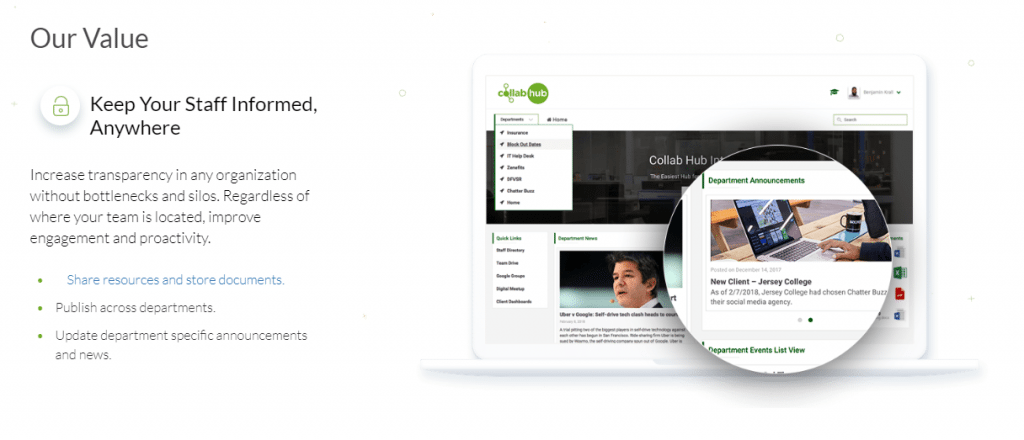What’s The Difference Between Intranet and Extranet and Why You Need Them
You’ve probably heard the terms internet and intranet, but what’s the difference? Everybody around the world uses the internet, but an intranet is mainly used by businesses to help connect their employees.
But if someone mentioned the terms intranet and extranet, would you know the difference?
They’re both systems used by businesses to improve methods of communication but in very different ways. In fact, the very terms “intra” and “extra” should help explain what they do differently. Learning about the difference between an intranet and an extranet can help you decide what is best for your business.
And if you’ve been considering an investment in either system, here are some things you should know about how your business can benefit by having an intranet – or extranet.
What’s The Basic Difference Between an Intranet and Extranet?

The difference is pretty simple:
An Intranet
Businesses adopt an intranet as a private network that connects employees within an organization. Think of it as a form of internal communication. Employees can use their company’s intranet to create content, communicate with one another, collaborate on projects, and post notices about upcoming events or company news.
It can be a more sophisticated system than relying on emails, for example.
It’s also a way to help develop corporate culture.
An Extranet
An extranet is similar, only it provides controlled access to a different group: authorized customers of the business, or vendors who frequently do business with the company.
Obviously, it creates a method of communication between people who conduct business with your firm in one way or another but are working outside of the company.
Still, whether your goal is to connect people inside your organization or to connect employees with external parties, the goal in both instances is the same: to encourage more successful collaboration, improve communications, and make it easier to share information.
However, these two internal systems are very different, and both of them require a distinct approach.
With an intranet, for example, you may want to use it to announce company news, update people on staff changes, and provide a staff directory with information about your employees. You’re going to want all of this information to be available to everyone throughout the company.
Intranets, in that sense, operate on the trust system—you trust that your workers and managers should get access to the information being released on it.
With an extranet, though, you want some control over the flow of information. Communication is shared with trust – and openness.
If you have an extranet that connects you to all your vendors and customers, clearly you need assurances that the flow of information gets controlled and even restricted at times. After all, you don’t want to share the information one vendor provided to you with other vendors using the system – that’s proprietary information that shouldn’t get leaked.
What you don’t want, obviously, is to generate confusion on how to use a combined intranet and extranet. If your vendors lose confidence in your ability to manage the information transmitted through the extranet, that creates problems for you.
But if you impose too many restrictions, then chances rise that your employees won’t use them. One of the biggest problems with intranets is they stop engaging employees, who decide not to bother using it.
And more than anything else, don’t forget that technology itself can become confusing.
So how do you solve these problems?
Setting the record straight on intranet vs extranet

A key to resolving this problem is understanding when a business should be using an intranet, and an extranet. It’s also a great place to start by having a strong grasp of both technologies and how they can help you and enhance your business’s performance.
The benefit of an extranet is that the site connects your managers, department heads and employees with external parties, making your interactions with clients and vendors that much easier and encouraging collaboration and a smoother flow of information sharing.
This can help make it easier to collaborate with customers and suppliers, and it can help encourage business partners to continue working with you.
A modern extranet is also about increased transparency. It allows your team to track the progress of work with clients and sure each project and deadline is being met.
As a private network, an extranet is often part of a company’s intranet, but extended to authorized users outside of the organization. However, unlike an intranet – where information is shared freely among your organization’s employees – an extranet requires security and privacy due to the nature of the information being shared.
Often times, this means a firewall server management and forms of user authentication are put into the system. That can give clients or vendors outside of your intranet access for business purposes – except that the access is controlled.
For example, say you want to jointly develop and launch training programs with other companies. That’s an ideal function for an extranet. Custom software development companies today often combine extranets and intranets, making communication that much easier and having the entire process streamlined.
Again, the main focus of an intranet is to enhance engagement among internal staff, such as communicating company-wide updates and encouraging interaction among workers – an internal business social network.
That information doesn’t go out on extranets, obviously, although they can enhance engagement with key third parties, and extranet software exists to bring value to your customers and suppliers.
Businesses need to understand what works best for them before adopting either one. If you want to improve the way you interact with customers or have a platform for communicating better with them, a system like Collab Hub can serve as your extranet.
The system can enhance your relationships with clients and vendors by offering a more efficient method of communication.
If you want to enhance communication tools among your workers, you can also use Collab Hub as your intranet.
It might work best to start off with an intranet and get your team used to the concept of how to use it. That can lead to a smooth transition when you then set up an extranet.
In both instances, these systems reflect the rise of the digital workplace, by providing tools that make it easier to connect remote workers to their colleagues, or workers to clients.
Systems like Collab Hub help address the issue of keeping remote workers engaged in the overall daily and weekly happenings at your business. For some industries, employer-to-employee communications start lagging. Workers don’t want tons of emails to sort through.
Intranets offer a far greater degree of flexibility.
Employee engagement is key. By giving employees access to needed documents and speeding up the process of document sharing and access can save workers a lot of time.
By setting up an extranet, employees get these same benefits, but with access to outside sources as well. If you have a business that sometimes needs to share documents with clients and vice-versa, an extranet becomes a great resource for you.
And your extranet can become an expanded form of intranet. In both cases, the systems are driving collaboration and communication, with high levels of data sharing.
The Collab Hub Advantage

Collab Hub is a software that can be used as either an intranet or extranet, depending on your company’s needs. If you’re wondering what features you should you be looking for from intranet software, it would normally include:
• The flexibility to use it quickly, without a lot of training.
• The ability to tailor it in the future to meet your needs as your company grows.
• A certainty that the developer is available down the road if you have questions or need assistance.
• A central hub where your workers can communicate and discuss ongoing projects.
• A centralized place where knowledge is posted, retained, and easily accessible.
• A system that fosters social collaboration within your company, giving all workers a voice.
• A gathering place for information from various sources – HR, department heads, individual workers, etc.
Collab Hub gives your company the tools needed to ensure that everyone, regardless of department or location, can communicate in the fastest, most reliable and efficient manner possible. It can be communication among employees – or with outside vendors.
Collab Hub uses the popular web hosting site WordPress, which is the easiest and most cost-effective intranet solution for small and medium businesses for team collaboration. And best of all: there are no monthly fees or regularly charges per worker.
For $1,299, it’s yours, with no additional fees applied.
Conclusion
By using Collab Hub, your workers will become far more engaged with their colleagues and supervisors. Your department administrators can give hundreds of workers the ability to coordinate tasks, so employees can work collaboratively on long-term projects.
So what are you waiting for?

Michael Freeman
Content Writer and Editor
Michael is the Content Writer and Editor at Chatter Buzz. A native of Massachusetts, Michael has lived in Orlando since 2002, and has more than 20 years of experience as a print and online journalist. Michael has worked at some of Florida’s top newspapers, including The Orlando Sentinel, The Sun Sentinel, The Lakeland Ledger and The Jewish Journal. Michael has also worked as a marketing writer for private firms, and his industry clients have included a property management firm, a real estate company and a political consultant. He has taught communications to college students. Michael earned his BA in writing and communication from Hampshire College and a Masters in political management from George Washington University.